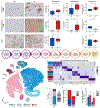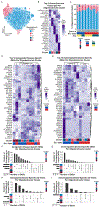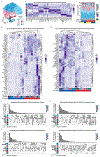Astrocytes and oligodendrocytes undergo subtype-specific transcriptional changes in Alzheimer's disease
- PMID: 35381189
- PMCID: PMC9167747
- DOI: 10.1016/j.neuron.2022.03.008
Astrocytes and oligodendrocytes undergo subtype-specific transcriptional changes in Alzheimer's disease
Abstract
Resolving glial contributions to Alzheimer's disease (AD) is necessary because changes in neuronal function, such as reduced synaptic density, altered electrophysiological properties, and degeneration, are not entirely cell autonomous. To improve understanding of transcriptomic heterogeneity in glia during AD, we used single-nuclei RNA sequencing (snRNA-seq) to characterize astrocytes and oligodendrocytes from apolipoprotein (APOE) Ɛ2/3 human AD and age- and genotype-matched non-symptomatic (NS) brains. We enriched astrocytes before sequencing and characterized pathology from the same location as the sequenced material. We characterized baseline heterogeneity in both astrocytes and oligodendrocytes and identified global and subtype-specific transcriptomic changes between AD and NS astrocytes and oligodendrocytes. We also took advantage of recent human and mouse spatial transcriptomics resources to localize heterogeneous astrocyte subtypes to specific regions in the healthy and inflamed brain. Finally, we integrated our data with published AD snRNA-seq datasets, highlighting the power of combining datasets to resolve previously unidentifiable astrocyte subpopulations.
Keywords: Alzheimer's disease; astrocyte; dataset integration; glia; heterogeneity; inflammation; neurodegeneration; oligodendrocyte; single-nuclei sequencing; spatial transcriptomics.
Copyright © 2022 Elsevier Inc. All rights reserved.
Conflict of interest statement
Declarations of interests S.A.L. is a founder of AstronauTx Ltd and a member of its scientific advisory board. All other authors declare no competing interests.
Figures







References
-
- Ando K, Uemura K, Kuzuya A, Maesako M, Asada-Utsugi M, Kubota M, Aoyagi N, Yoshioka K, Okawa K, Inoue H, et al. (2011). N-cadherin regulates p38 MAPK signaling via association with JNK-associated leucine zipper protein: implications for neurodegeneration in Alzheimer disease. J Biol Chem 286, 7619–7628. 10.1074/jbc.M110.158477. - DOI - PMC - PubMed
Publication types
MeSH terms
Substances
Grants and funding
LinkOut - more resources
Full Text Sources
Medical
Molecular Biology Databases
Miscellaneous

